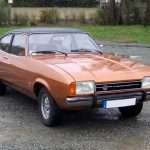There was again a sense of chasing a unicorn. It is only a few weeks ago that it seemed a Ford Cortina Estate was on the road ahead; accelerating to catch it, the Cortina, that icon of 1970s Britain, metamorphasised into a bland Japanese model from the 1990s. This time, the sighting seemed more certain.
Edging out of a gravel driveway of a cottage set back from a road, its fence breaking the sightline to the right, there was a flash of orange and black as a car passed at speed, its engine audible as a deep throaty sound. There could be no mistake this time, this was not a Japanese vehicle; this was a Ford from the days of legends.
If it was what it had appeared to be in the brief glimpse, there would be no prospect of catching it on open road; the only chance of verifying that it was not another piece of imagination would be if it had caught caught behind another vehicle or had been delayed by traffic lights at the edge of the town.
Passing the houses that marked the beginning of the first of the streets, the orange vehicle was visible, hardly moving due to a tractor ahead. There was little effort in moving closer: a 1976 Ford Capri Ghia with orange bodywork and black roof. The paintwork was unmarked, the chrome rear bumper was gleaming. The driver appeared of a vintage that might have driven the car when it was new.
The Ford Capri was flash; it was intended to be so. The vivid orange, the two tone colour scheme; these were intended to attract attention, to make people notice and to say, ‘there’s a Ford Capri’.
Having gone through life without driving any Ford other than a Transit minibus, it is odd to be driving down a country road in hope of spotting a Capri, but it’s part of a bigger picture, a thread in a tapestry, a piece in a jigsaw.
The Capri was instantly recognizable because 1970s culture was much more homogeneous; there were images, ideas, thoughts that were shared across the population. Music for people in an age spread of twenty years, maybe more, was summarised each week by BBC television’s ‘Top of the Pops’. Television came in three channels, and given that most of us did not watch BBC 2, unless there was sport; it was really a choice between BBC and ITV. We watched the same programmes, inhabited the same culture, knew what was ‘flash’ and also what was not.
Digital television, social media, music downloads, online entertainment – the choices are abundant, but with the multiplicity of options comes a loss – there is no car now that would be instantly recognized and that would instantly convey the messages of the Ford Capri. We have lost a sense of something common to us, a sense of something shared.
